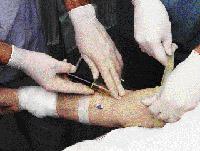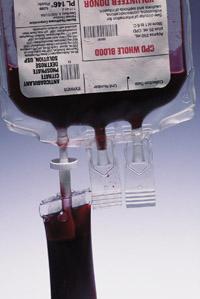Unknown but important hepatitis C

The Round Table was held in the Assembly Hall of the Association, and in the presence of numerous interested assistants, was attended by the following specialists and experts, who addressed as a general theme: Hepatitis C: diagnostic and therapeutic criteria.
The moderator was Dr. Miquel Bruguera Cortades, member of the Association of Hepatology and president of the Association of Doctors of Barcelona.
The speakers were:
- Dr. Gustavo Olla Eguiluz, specialist in Microbiology.
- Dr. Agustín Castiella Eguzkquiza, Digestive System Specialist
- Dr. Manuel García Bengoechea, Digestive System Specialist.
Collecting in some way what was said in the round table, below we offer a last kind of review on hepatitis C. Thank you to García Bengoechea for your collaboration.
Introduction
In the 1980s, the name “no -A, no -Hepatitis B” was used for hepatitis caused by both virus A and virus B, since according to the rest of the data the generating agent was a virus. In 1969 M. The results of the research carried out by a group led by Houghton in California (USA) were exposed to the public and allowed to characterize the creative virus (called C virus), as well as the technical possibility of looking for antibodies in blood to detect people carrying the virus. This enabled screening programmes between blood donors starting in 1990, thus avoiding hepatitis by transfusions.
Spread of infection

The current incidence (number of infections) is low (estimated between 1 and 3 cases per 100,000 inhabitants per year), but patients with hepatitis C are often still diagnosed, most of whom have been infected for years without knowing it. Most cases of findings occur in conventional blood tests or for blood donation purposes. Hepatitis C virus (hereinafter HCC) is currently responsible for 50% of liver disease (70% of all chronic hepatitis, 40% of cirrhosis, 60% of hepatocellular carcinoma, 30% of liver transplants).
There are no big differences between countries, but although the data are not absolute, it seems that in the countries of southern Western Europe there are more people infected than in the countries of the north. From the prevalence, that is, the percentage of those affected at a given time, the figures of carriers of the infection are usually extracted by estimation. In our area, between 2% and 2.5% of the population can suffer infection (hence the figure of 50,000 people initially infected). According to recent studies conducted in the United States, 1.8% of the population has antibodies against CHB (therefore, has had contact with the virus) and three-quarters of the population suffers active infection. Based on this data, it is estimated that around the world there are 150 million people affected, and as already mentioned, about 50,000 in the ACBC.
Transmission

Transmission of hepatitis C occurs mainly when infected blood enters the recipient's circulation. Therefore, we must think that the forms of contagion are related to infected human blood or tissues. In other body fluids (such as urine, semen, vaginal fluids, etc.) no virus has been normally found, so for now no transmission pathways are considered.
Since the virus is transmitted almost exclusively by blood, the most common forms of contagion (and therefore susceptible to be considered as risk procedures) are the following: intravenous drug use when material is shared, blood transfusions performed before 1991 (currently the risk of hepatitis C is almost 0%), skin piercing techniques with any potentially contaminated material (e.g., piercing, medical procedure or any tattoo misused).
It can also be transmitted from mother to child (it is estimated that these cases are 5% at present): it occurs at the time of delivery or at moments immediately prior to delivery.
Prophylaxis or how to prevent
- Avoid parenteral drug use and other ways: more and more cases of hepatitis C have been detected among those taking drugs by nasal route.
- Avoid maneuvers or procedures that perforen the skin and do not offer guarantees of sterility.
- Condom use is recommended in sexual intercourse with promiscuity. In sexual intercourse with the specific partner there are no concrete recommendations: take protective measures in case of genital disease and it is recommended not to have sex during menstruation.
Treatment
Treatments are aimed at chronic hepatitis.
In the late 1980s, the first research was conducted to demonstrate the effectiveness of interferon in hepatitis C (the disease was not yet called hepatitis A, not B). This first trial had good results. During the 1990s, interferon has continued to be used as a relatively standard treatment of hepatitis C, and in patients treated in 6-12 months, infection has been cured in 15-20% of cases.
In recent years, another drug (called Ribavirin) has also been treated that appears to be on the market immediately and that when combined with interferon, between 30 and 90% of cases are resolved.
At the moment there is no other treatment, awarded with sufficient guarantee, that can suppose its use in a short period of time. The aforementioned treatments are long (5-12 months), quite uncomfortable and with side effects.
Types of hepatitis

We have characterized 5 types of viruses (and therefore well separated and identified) capable of producing hepatitis: Virus A, B, C, D and E. All are different. The form of infection varies from one to another, and to differentiate it is a very important fact its ability to produce a chronic disease, that is, an irreversible damage (cirrhosis) in its evolution. While viruses A and E can only cause acute hepatitis, viruses B, C and D, in addition to acute hepatitis, can also produce chronic hepatitis.
All types of viruses can be captured, as viruses are different. Therefore, immunization left after hepatitis only prevents transmission of the same kind of hepatitis in most cases.
Other interesting facts
It should be noted that most chronic hepatitis caused by B or C viruses are almost symptom-free and often found unexpectedly in analysis.
One of a person's habits or behaviors is the one that can turn chronic hepatitis into liver cirrhosis: drinking alcoholic beverages. Therefore, in these cases alcohol is totally prohibited.
There are vaccines to prevent hepatitis A and B. Hepatitis B vaccination is carried out systematically in schools today (highly recommended). In a document recently published by the Spanish Liver Association recommends the general vaccination of hepatitis A, taking into account the existence of a “double” vaccine that allows immunization against both hepatitis.
The study covers several aspects currently around hepatitis C, with C virus being the main object of study: aggressiveness, or how to escape human defenses, or sensitivity to treatment, some of the points being investigated. However, the absence of experimental models (only man and chimpanzee are infected with C virus) and poor reproduction “in vitro” are important difficulties in fighting hepatitis caused by C virus.
- In the CAPV there are about 50,000 people affected by hepatitis C.
- Few patients know they are affected.
- There are no symptoms.
- It can only be detected by a blood test.
- There is no specific risk group, it can be supported by anyone.
- The patient is prohibited from drinking alcohol.
- Care with tattoos, piercing, etc., always guaranteeing the conditions of sterility.





